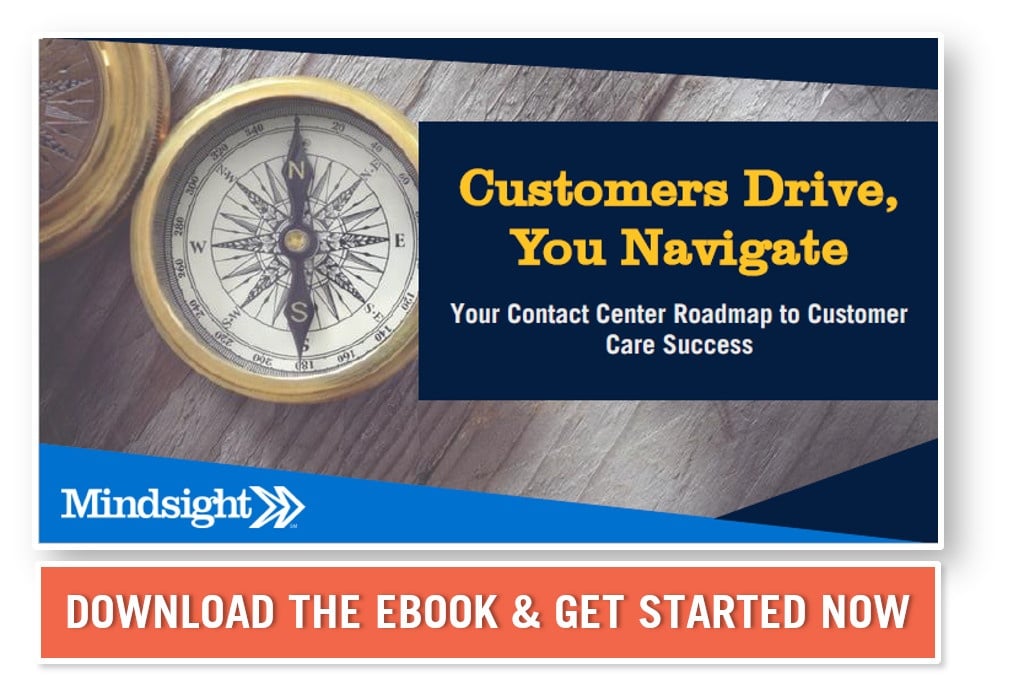November 5, 2019 by Siobhan Climer, John Irey, and Kleid Gjataj
74% of U.S. consumers have contacted customer service by phone. In fact, it is the most-used channel, far more so than email or live chat. Yet over a third of U.S. consumers identify call centers and specifically automated telephone systems/IVRs as the most frustrating aspect of customer service.
There’s a reason people hate using the phone. Many customers cite the inability of customer service representatives (CSRs) to resolve issues and the constant need to repeat information as highly frustrating. In a 2019 Customer Expectations Report by Gladly, 54% of consumers would rather spend a day in wet socks than repeat themselves.
Until now, we were confident wet socks were the worst.

Contact Center Frustrations: The Agent’s Perspective
Contact centers are disliked for a variety of reasons. It’s important to note that contact center agents also dislike their work; some contact centers have attrition rates that hit the triple digits and even the average turnover in the call center is three times that of other industries.
Last summer, we wrote about the challenges contact center leaders face in attracting and retaining talent. We noted that contact centers that use flexible work models, innovative hiring practices, positive CSR empowerment policies, and technology have the best chance of retaining top talent.
While a disgruntled or bored-sounding agent certainly isn’t going to improve a customer’s experience, it is not the only reason customers dislike calling the call center.
Top 5 Reasons Why Customers Hate Call Centers
IVRs
 When asked about the most frustrating service experience, customers cite over and over the frustrations of interactive voice response (IVR) systems. IVRs are invaluable to contact centers: they improve operational efficiencies and they can save customer’s time.
When asked about the most frustrating service experience, customers cite over and over the frustrations of interactive voice response (IVR) systems. IVRs are invaluable to contact centers: they improve operational efficiencies and they can save customer’s time.
Yet the reality is that a combination of poor voice recognition, complex navigation menus and misnomers, endless loops with no escape, automatic call disconnects, and poorly executed scripts leave customers frustrated and searching for alternative solutions – like your competitors.
Multichannel Vs Omnichannel
Despite the hype and investment, most contact centers today remain siloed multichannel entities. Businesses have added social, email, live-chat to their current voice platforms; yet rarely have they integrated them to reduce repetition. Customers HATE repeating themselves, whether that’s repeating their name to the same agent twice, or repeating their name over and over and over as they are transferred from representative to representative.
 To be truly omnichannel, contact centers must integrate these various channels seamlessly. If a customer chats with someone on your website (an AI or a person) and then calls your call center, it is essential your representatives know the customer was on the website, what they were hoping to learn or solve, and what steps have already been taken to resolve the issue.
To be truly omnichannel, contact centers must integrate these various channels seamlessly. If a customer chats with someone on your website (an AI or a person) and then calls your call center, it is essential your representatives know the customer was on the website, what they were hoping to learn or solve, and what steps have already been taken to resolve the issue.
Agents
We mentioned it earlier, many agents hate their jobs. One agent we spoke with described working in the call center as “a nightmare, a disaster.” They went on to claim a number of causes, including “disrespect by management”, “zero-tolerance policies for things like being five minutes late and getting sick”, and when company “polices stop you from helping your caller”.
During customer service training for phone representatives, agents are instructed to smile when they answer the phone because customers “can hear a smile.” It’s true. If agents are treated poorly, customers hear that as well.
Please Hold For The Next Available Representative
Folks are busy. When they pick up the phone to schedule a doctor’s appointment or follow-up on their new Bluetooth speaker, they do not want to twiddle their thumbs for 10 minutes.
 Not to mention that customers are holding while listening to scratchy elevator music. The experience when calling the call center is complex and layered. A hard-to-dial phone number, complex IVR, multi-transfers, and wrong answers (or worse, “I believe” or “I think” statements) added on to bad music make long hold times the enemy of the call center.
Not to mention that customers are holding while listening to scratchy elevator music. The experience when calling the call center is complex and layered. A hard-to-dial phone number, complex IVR, multi-transfers, and wrong answers (or worse, “I believe” or “I think” statements) added on to bad music make long hold times the enemy of the call center.
“Beeeeeeeep”: The Dreaded Dial-Tone
The customer did their best. They pressed ‘1’ then ‘3’, spoke to Harry, then to Maude, were transferred to Jessie, then to Louise, and finally – in the midst of being transferred to Darryl – they hear the sound of a dial-tone.
Take a moment to imagine their frustration! They spent 19 minutes and 42 seconds (remember: they can look at their phone to see precisely how long their call lasted) navigating a menu, explaining their issue to multiple representatives, all to be hung up on. Either they call again, doubly frustrated, or they decide right then and there to never do business with you again.

What Can Call Centers Do Better?
These experiences would be harder to describe if they were infrequent; unfortunately, almost everyone is familiar with the pains of calling customer service. That’s because creating an optimized call center system and IVR is very, very hard.
That’s why Mindsight’s expert-level-only engineers specialize in the design and implementation of high-performing IVRs and call center systems. Building a phone tree and implementing the right technology solutions to deliver an effortless experience for your customers is what we do best.
Want to know more? Schedule some time to talk one-on-one – by phone, chat, or in-person – with our contact center experts. During our complimentary whiteboard sessions we learn about your environment and provide advice on how you can deliver the best experience to your customers.
Like what you read?
Contact us today to discuss why customers hate call centers – and what you can do about it.
About Mindsight
Mindsight, a Chicago IT services provider, is an extension of your team. Our culture is built on transparency and trust, and our team is made up of extraordinary people – the kinds of people you would hire. We have one of the largest expert-level engineering teams delivering the full spectrum of IT services and solutions, from cloud to infrastructure, collaboration to contact center. Our customers rely on our thought leadership, responsiveness, and dedication to solving their toughest technology challenges.
Contact us at GoMindsight.com.
About The Authors
John Irey is a Principal Consultant at Mindsight, an IT Services and Consulting firm located in the Chicago area. With nearly 20 years of experience in information technology, John has helped businesses of every size optimize the technology powering the contact center. He has extensive experience with contact center technologies and seeks to provide a consultative voice to contact center leaders, who rely on Mindsight’s transparency to make the best technology investments. John earned his BA/BS in Information Systems and continues to focus on how emerging technology, such as machine learning and artificial intelligence, impact the contact center. John enjoys spending his free time with his wife and two young children.
Kleid Gjataj is the Principal Solutions Architect at Mindsight, an IT Services and Consulting firm located in the Chicago area. With nearly 15 years of experience in both domestic and international consulting, Kleid has helped contact centers of all sizes to bridge the gap between business and technology. His extensive experience with IVR, ACD, screen pop, omnichannel, speech analytics, quality management, outbound dialer, and custom applications is grounded in understanding the critical value of the customer journey. Kleid earned his degree in Network and Communications Management and continues to focus on how contact center optimization helps businesses meet goals, increase efficiencies, and reduce costs.
Siobhan Climer, Science and Technology Writer for Mindsight, writes about technology trends in education, healthcare, and business. She writes extensively about cybersecurity, disaster recovery, cloud services, backups, data storage, network infrastructure, and the contact center. When she’s not writing tech, she’s reading and writing fantasy, gardening, and exploring the world with her twin daughters. Find her on twitter @techtalksio.




